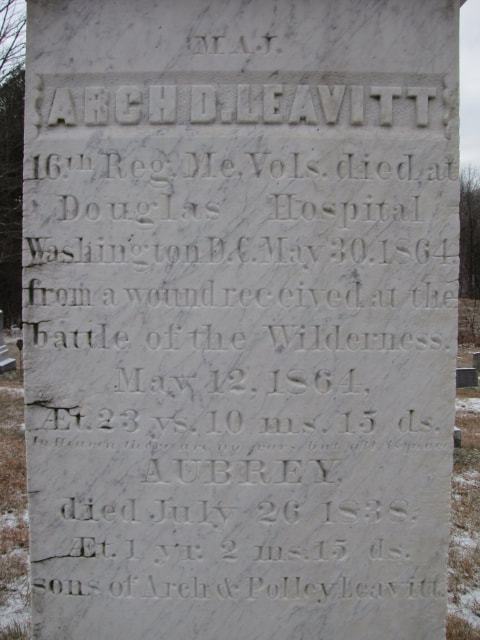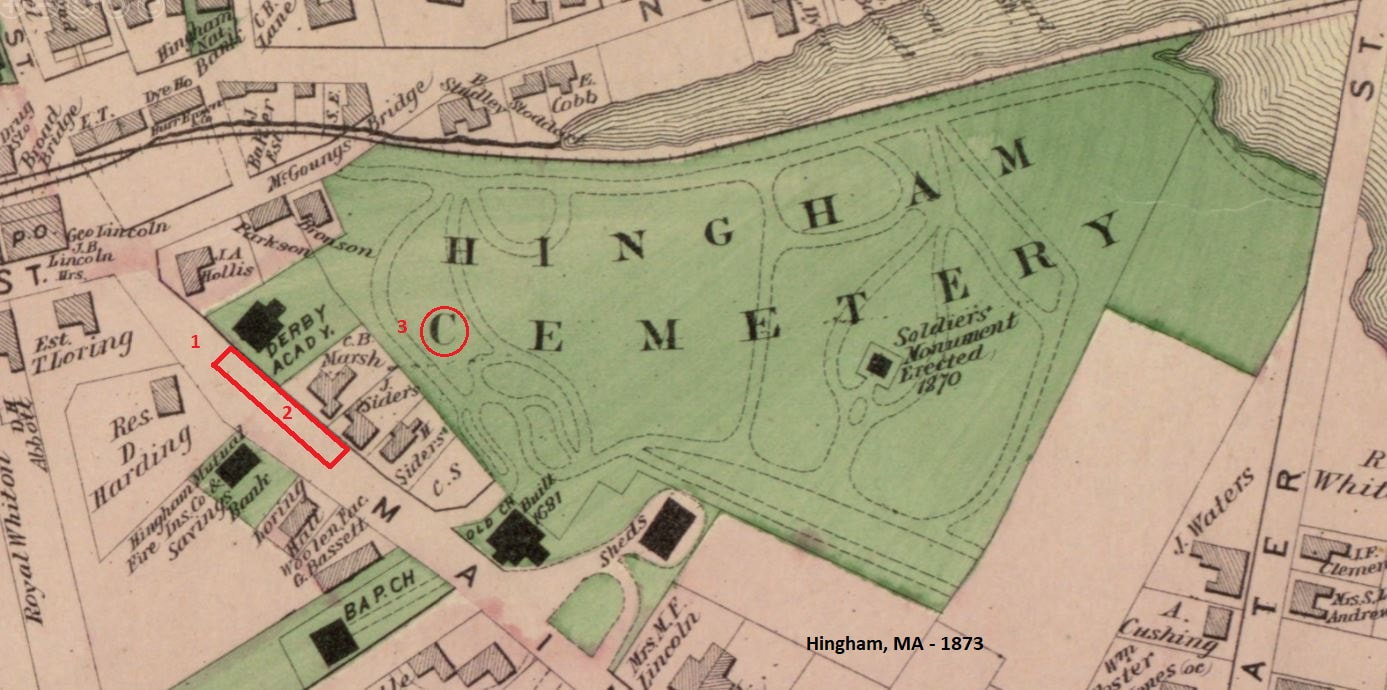Brothers Aubrey and Archibald D were early participants in the Civil War, taking part in the raising of a company that would be part of the 16th Maine Infantry, a 3-year unit. Both were mustered into service on 14 Aug 1862, Aubrey as sergeant of Co E (later promoted to 2nd Lt). Arch, initially captain of the same company, would become Major of the regiment, but was mortally wounded (in left clavicle) in battle, and died in Douglas Hospital, Washington, DC on 30 May 1864 (the 29th is also seen for death date). While the "Register of Deaths of Volunteers" lists him as buried in the Soldiers' Home Cemetery in DC, the Sixteenth Maine book (pg 230) says "His remains were brought to Turner and buried with Masonic honors". The Colby College website has a photo of Arch D Leavitt: http://lgimages.s3.amazonaws.com/data/imagemanager/18248/arch_leavitt.jpg Arch was a graduate of Colby College, Waterville, Class of 1862. His fellow fraternal brothers in Delta Kappa Epsilon, upon hearing of his death, had the following "Tribute of Respect" printed in the Portland Daily Press, on 30 June, 1864 (pg 3).
0 Comments
John Wood Leavitt was sixteen years and six months old when he left the family farm in East Winthrop, Maine , and took the 10-mile trek to Augusta. He had just enlisted, on the 20th of November 1863, as a "20"-year old, enrolled by "A.S." (Arnold Sweet) Richmond, a fellow townsman and acting deputy provost marshal. As a private in the Seventh Maine Battery (of Light Artillery), he was mustered into service for three years, on 30 Dec. 1863. Through the month of January, 1864, while other volunteers continued to arrive, the men were formed into detachments and drilled on a daily basis at Camp Coburn in Augusta. At the end of the month, John Leavitt received a state bounty of $100, as well as a U.S. bounty of $60 and $13 monthly advance pay. The unit left the capital on the morning of 1 Feb. and headed south. Transported via rail and steamer, the 7th Battery arrived in Washington, DC on the morning of 5 February 1864, and settled into Camp Barry, the Artillery Camp of Instruction. Having already left a few men behind in Augusta due to sickness, the camp life and change of climate continued to take its toll. A letter, written by someone stationed at Camp Barry and published in the Oxford Democrat on 8 April 1864, pg 2, mentioned the 7th Battery: "It came here with 143 men...[ ]. There has been much sickness in this company since its arrival. Four have died..." John W Leavitt was one of those four men, succumbing to double pneumonia on the 16th of March, 1864. He was two months shy of his seventeenth birthday. His body was returned home, where he was buried in the East Winthrop Cemetery, beside his sister Mary, who had died in 1860, at age 14. Notes/sources:
Photos taken 21 Sept 2019 (by S. Dow) Descendants of John Leavitt Through His Son, Israel and Lydia Jackson (pg 77) History of the Seventh Maine Light Artillery (archive.org) Seventh Maine Battery Descriptive Roll (pg 63); Monthly Return (pg 195); Muster In Roll (pg 108 pay, pg 109); Muster Out Roll (pg 130) Maine, Civil War Enlistment Papers: John W Leavitt (Declaration of recruit) - being under 21 years of age, a parent or guardian needed to sign a consent form. As seen below, John's father Hiram H. Leavitt signed off on his son being 20 years old. In the Hingham Centre Cemetery sits a brick monument, atop which lies a now undecipherable slab. Sharing this lot are the gravestones of Israel Leavitt (d. 1696, though stone says 1690 or '99), and his father John Leavitt (d. 1691). This is the tomb of Jacob Leavitt, the great-great-grandson of Deacon John, and the man who is said to have been responsible for having the remains of his ancestor(s) reinterred here. As is evident today, the stone monument is easily covered by lichens, which makes any inscriptions impossible to read. However, we do have a record of what was written, or at least a partial transcription. In 1996, NALF officers hired a Weymouth, MA man to repair the brick work and to clean the slab of growth [NALF Cemetery Report, 1996; reprinted in Desc. of Israel Leavitt 1997 Update, pg 93]. When completed, only the following could be read: JOHN LEAVITT DIED 1 - 9 - JACOB LEAVITT DIED JANUARY 1826 AGED 85 ----- WIFE DIED ----- ----- AGED ----- Jacob Leavitt died on 7 Jan 1826, and his wife Leah (Fearing) died on 14 Oct 1838. With the grave markers of Israel and John Leavitt also in this lot, and John's name inscribed on the stone, one would hope their remains (had they survived over a century underground) were also removed from their original burying places near the Old Ship Church (see below) when the stones were brought over to the Plain. The question is, who else is buried in this tomb? In his will [Plymouth County Probate, case #12506], dated the 6th of July 1824, he wrote that his "tomb should be kept for the use of the family to the latest generation". Jacob Leavitt had nine children, and most of them had offspring of their own, so there may have been two dozen people of the "latest generation" at the time of his will being written. Two of his sons were deceased by 1824: Benjamin and Elijah. While the former had moved to Portland, Maine and died there, the latter passed away in Hingham but there's no record of his burial place. With three of his children having stones in front of this lot (so either buried there or were placed in the vault), Elijah is very likely in the tomb with his parents. Most of Jacob's other children and their families have lots elsewhere in the Centre Cemetery, so did not take up the offer left to them by their father. Daughter Lydia (wife of Edward Battles) died in Charlestown, MA in 1860, her death rec says she was buried in Hingham, and may be with her parents.
Fifty years of burials had taken place there in the 1600's, though it seems most were without gravestones. A single burial plot was made for the majority of them in the Hingham Cemetery where, in 1839, the town erected a large monument in their honor. Those grave markers that did exist were placed around this new location. On the 1873 map below, [1] is Main St., where its shape bears the evidence of running alongside the southern part of the hillside [2] that once sat there. [3] is the reinterment place of those bodies removed during the road construction. As late as 1877, bodies were still being dug up at this location [History of Hingham, Vol 1, Part 2, pg 356], found in front of the homes of Caleb B. Marsh and John Siders (as can be seen beside the Derby Academy on the above map). Their houses, built in the 1750-70's (according to the tax assessor database), shared the hill with the burial ground. From a 2017 street view, the Academy building (now the Historical Society, left), the Marsh home (right), and the Siders place (far right) all stand, and this viewing angle helps show how the hillside had been cut away. While it is said [Desc. of Israel Leavitt, pg 22] that Jacob Leavitt was the one responsible for the reinterment of Deacon John (and presumably Israel, as well) to the "Plain" (now the Centre or Center) Cemetery, this project was done prior to the town's 1831 vote for the removal of the original burial ground, as Jacob died in 1826. Perhaps, in the years prior, town meetings had proposed the excavation on Main Street, so Jacob Leavitt took the initiative and had his ancestors saved from a mass burial by having them brought over to his tomb prior to his death.
See also: A Visit with Deacon John |
gravestones and their storiesMore than just names and dates engraved on a grave stone, a look into the Leavitt families found in our cemetery photographs. Archives
August 2023
Categories
All
|












 RSS Feed
RSS Feed